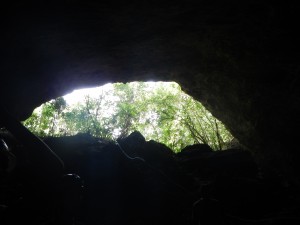Today was a bit low on cockroaches, mostly because our group was out busily setting up our pitfall traps. We wanted to analyze differences in nitrogen limitations (AKA organisms desire for nitrogen compounds) between creatures that live high in the forest canopy and those that live on the ground since distribution of nutrients is different in those locations. These traps held nitrogen bait (human urine!) and served to trap insects within. One trap was set onto a tree and another on the ground. Maybe this will be a good chance to see a few roaches!
Most of the roaches that I have found in Belize were often under a pile of leaves, feeding on decaying matter. The advantages of such a bottom-dweller lifestyle is double edged. Dead materials are not usually heavily competed for due to abundance of microbes and leaf litter provides excellent protection from predators and aspiring entomologists like myself. Perhaps in light of this, I can predict that if the traps can fit roaches, then I should find more roaches in the ground traps than in the tree traps. But whether their contribution to our question on differences in nitrogen limitations of the canopy and the ground will matter is up in the air until tomorrow when we retrieve our traps. Before then, I can only guess.
A roach was sighted during a noon leisure excursion to one of the Las Cuevas trails. It was tiny, wingless and fast moving. I tried to snap a photo, but it managed to hide a part of its body behind one of the spines of a give and take palm. Better than nothing I guess! I could improve my roach findings by perhaps searching during one of our night hikes!
Other than trap setups, our team visited a cave near where we lived, learning about the caves history and use by the ancient Mayan societies as a ceremonial ritual between their chief and the nine realms of the underworld that each section of the cave represented. In spite of the uneven terrain and low oxygen levels, I was captured by the mystery surrounding the cave structures and biological life! We spotted bats, tiny insects like diplurans, isopods, crickets, and even large millipedes, and learned how these creatures were sustained by cave nutrition. This may come in the form of droppings by bats or by nutrients entering the cave. No roaches, so bummer for me, but exciting nevertheless to explore one of the mysterious habitats of the earth!

P.S: speaking of mysteries, we found a peccary skeleton in a tiny chamber of a cave. I wonder how it got there? Did it wander through the pitch-black cave and get lost, or was it brought in as sacrifice by an ancient tribe.
